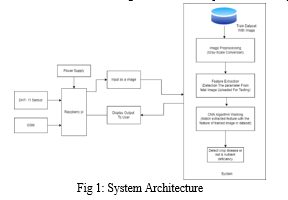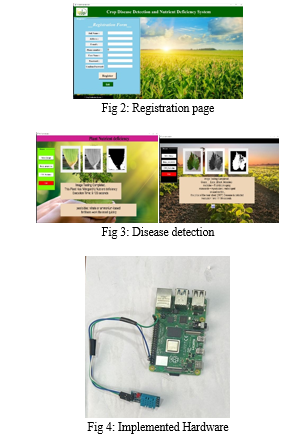Ijraset Journal For Research in Applied Science and Engineering Technology
- Home / Ijraset
- On This Page
- Abstract
- Introduction
- Conclusion
- References
- Copyright
A Deep Learning Based Framework for Accurate Prediction of Disease of Crops and Nutrients in Smart Agriculture
Authors: Prof. Sonali Badade, Aashu Bamane, Sayali Bhagat , Alka Chande
DOI Link: https://doi.org/10.22214/ijraset.2024.60198
Certificate: View Certificate
Abstract
The health and production of crops have a major impact on societal well-being, and agriculture is essential to maintaining global food security. Crop output and quality are greatly impacted by nutrient shortages and crop diseases. We offer a unique approach to this problem that makes use of the Raspberry Pi, an inexpensive, small, and energy-efficient single-board computer, to forecast crop illnesses and identify nutrient deficits in real time. Our solution provides farmers and other agricultural stakeholders with fast and accurate information for efficient crop management by combining computer vision, machine learning, and sensor technologies. The Raspberry Pi has many sensors to assess ambient and soil conditions in addition to a high-resolution camera for taking pictures. Using a machine learning model trained on a variety of datasets pertaining to agricultural illnesses and nutritional deficits, the system takes pictures of crop leaves and soil conditions. Preprocessing images, feature extraction, and convolutional neural network (CNN)-based categorization are important parts of our approach. The system can recognize evidence of nutrient deficits, such as nitrogen, phosphorus, and other deficiencies, as well as symptoms of a variety of crop illnesses, including fungal infections, bacterial blights, and viral diseases.
Introduction
I. INTRODUCTION
Many economies rely heavily on agriculture, and maintaining crop health is essential to both sustainable agricultural methods and food security. Food shortages and financial losses can result from crop diseases and nutritional deficits that significantly reduce crop yields. Innovative solutions may be developed by utilizing contemporary technology, like the Raspberry Pi, to tackle these difficulties. The Raspberry Pi is a single-board computer that is small, inexpensive, and multipurpose. It has been used in a variety of industries, including agriculture. The GPIO (General Purpose Input/Output) ports, small size, and low power consumption of this platform make it perfect for creating projects linked to agriculture. To detect crop disease signs, using machine learning and image processing techniques. Utilize a camera module that is attached to the Raspberry Pi to take pictures of the crops. Examine the photos to see any possible disease indicators, such as yellowing, wilting, leaf patches, or abnormalities. To accurately forecast diseases, compare the results with a pre-trained illness database. Use sensors such as pH meters and soil moisture sensors that are linked to the Raspberry Pi to keep an eye on the nutrients and soil conditions. Examine the information obtained from these sensors to identify any deficits or imbalances in important nutrients like as potassium, phosphorus, and nitrogen.
Make suggestions for remedial measures, including modifying the way fertilizer is applied. A promising use of technology in agriculture is the use of Raspberry Pi for nutrient deficit diagnosis and crop disease prediction. To boost crop productivity and enhance the quality of agricultural products is one of the main goals of this application. Farmers may improve yields and cultivate healthier plants by promptly correcting crop illnesses and nutritional deficits by recognizing them early on. Significant losses in agriculture can be caused by nutrient deficits and crop diseases. Farmers may lessen crop losses and limit the amount of damage by anticipating these problems, which can have positive economic effects. It provides farmers with cost-effective, data-driven insights. Plant diseases are the primary cause of significant global food losses in the agriculture industry. Food losses resulting from crop illnesses caused by pathogens including viruses, bacteria, and fungus are a recurring problem. A second complicating factor in this circumstance is the ease with which illnesses may now spread over the world. Crop protection is crucial for reducing disease-induced harm to crops while they are growing. Traditionally, farmers or specialists with some training or experience were responsible for crop inspection and diagnosing plant problems. Due to the need for constant observation, this manual approach proved costly and impractical for bigger areas. Even skilled agronomists and plant pathologists are unable to fully understand the complexity and variety seen in a wide range of farmed plant diseases.
II. LITERATURE REVIEW
India is a country where the majority of the population makes their livelihood from agriculture and industries connected to it. A significant portion of the nation's GDP comes from agriculture. It is also among the nations that experience severe natural disasters like floods or droughts that harm crops. The farmers suffer significant financial losses as a result, which drives them to commit suicide. Accurately forecasting crop yields far in advance of harvesting can assist government agencies and farmers in making informed decisions about things like minimum support price setting, storage, exporting, and import/export. It takes a methodical analysis of vast amounts of data from several factors, such as soil quality, pH, EC, N, P, and K, to accurately forecast a crop far in advance [1]. In order to accurately forecast a crop, a thorough analysis of vast amounts of data derived from several factors, such as soil quality, pH, EC, N, P, and K, is necessary. Since crop prediction involves dealing with enormous datasets, this prediction method is ideal for data mining applications. By use of data mining, we are able to extract information from vast amounts of data. This paper reports on a research on several data mining methods that are used to agricultural production prediction.[2]. Every nation is known for its agricultural sector, which is undergoing a revolution of its own at the same time as the industrial revolution. Our survival depends on crops. One of the greatest worldwide problems facing modern mankind is food instability, which is the primary cause of crop illnesses. Plant diseases not only pose a worldwide threat to food security but may also have a substantial detrimental impact on human well-being. Thus, crop health is critical to both food safety and the economy. The only indicators of a crop's health are its growth and leaf condition. Therefore, by examining leaf image symptoms, information about many plant diseases will be offered [3]. A farmer may become afflicted with any number of illnesses that might harm food plants, such potatoes, tomatoes, or peppers. A particular type of bacteria causes late blight, whereas a fungus causes early blight. If farmers can detect these illnesses early and treat them successfully, they can save money and waste. In less than 25 years, there will be more than 9 billion people on the planet. There has to be a 70% increase in food production in order to keep up with the growing demand for food. A serious issue in many nations, particularly those with an agricultural economy, is crop disease. Diseases that affect potatoes are concerning, especially as they are the most widely consumed vegetable worldwide. However, the illnesses that affect tomatoes and peppers are also quite concerning. Remembering the age-old adage, "Prevention is better than cure." Scientists studying agriculture have been experimenting. Machine learning algorithms have shown promise by extracting data from real-time photo processing, thanks to the huge advancements in computers. Not to add that deep learning is becoming more and more popular, it is quite important. It makes people's daily lives more convenient, which makes a huge contribution and will keep on doing so in the future [[4], [5], [6]]. Bangladeshi and Indian farmers have historically depended on their own expertise and experience to diagnose crop illnesses due to restricted access to agricultural professionals in rural regions. The condition can occasionally be identified by a professional, but treatment is frequently too costly, labor-intensive, and time-consuming to be used extensively in poor countries. A great deal of research has been done to solve these issues by creating solutions based on artificial intelligence (AI). Crop damage may be significantly reduced by using machine learning or deep learning techniques to speed up the detecting process [7].
III. METHODOLOGY
In this project, we build deep learning for crop disease detection and smart agriculture systems. For crop disease prediction, the CNN algorithm was employed, and many sensor types were used for smart agriculture. The main controller of the system is the Raspberry Pi. The DHT-11 sensor monitors the humidity and temperature of the surrounding air. An equipment for quantifying nutrients in soil is used. The farmer will receive an alarm message via GSM if crop sickness of any kind is predicted.

A. Steps Involved
- Gather a Large and Diverse Dataset of Images Containing Healthy Crops and Crops with Various Diseases: Assemble a sizable and varied collection of photos showing both healthy and sick crops. Every image in this dataset has to be tagged with the appropriate ailment or state of health. This process is known as labeling the dataset.
- Data Preprocessing: Adjust each image's size to be the same. CNN input layers typically have pixel sizes of 299x299 or 224x224.Pixel values should be normalized to a similar scale, usually between [0, 1] and [-1, 1].Add to the dataset by transforming the photos using techniques like flips, rotations, and brightness modifications. Augmenting data facilitates better model generalization.
- Split the Data: Separate the training, validation, and testing subsets from the entire dataset. A typical allocation is 15% for testing, 70% for training, and 15% for validation. The model is trained on the training set, hyperparameter tweaking is done on the validation set, and performance evaluation of the finished model is done on the testing set.
- Build the CNN Model: Create the CNN's architecture. Several convolutional layers, pooling layers, and fully linked layers are usually included in this. Pre-trained models such as VGG, Res Net, or Inception can be used and adjusted to your particular purpose.
- Training: Utilizing back propagation, train the CNN with the training set of data. Iteratively change the model's weights to reduce the training data loss as much as possible. To avoid overfitting and to keep an eye on the model's performance during training, use the validation data.
- Deployment: After achieving desired results with the model's performance, use it to identify crop diseases in a real-world setting by putting it in a web application.
Artificial intelligence (AI) in the form of machine learning (ML) makes it possible for software programs to improve their prediction accuracy without having to be specifically designed to do so. In order to forecast new output values, machine learning algorithms use past data as input. The study of computer algorithms that can automatically get better with practice and with the use of data is known as machine learning, or ML. It is considered to be a component of AI. Without being specifically taught to do so, machine learning algorithms create a model using sample data, or training data, in order to make predictions or judgments. Machine learning algorithms find extensive usage in fields including computer vision, speech recognition, email filtering, and health, where they provide challenging or impractical to create traditional algorithms that can do the required tasks. While not all machine learning is statistical learning, a portion of it is strongly associated with computational statistics, which is computer-based prediction. Machine learning benefits from the methodology, theory, and application fields that the study of mathematical optimization offers.
B. CNN, or Convolutional Neural Network
A Convolutional Neural Network is a type of Deep Learning algorithm that may be used to analyze an input image, prioritize distinct elements or objects within the image, and distinguish between them. This particular type of artificial neural networks is gaining popularity in radiology and is becoming the industry standard for many computer vision applications. CNN uses many basic elements, including
- Convolution layers, to automatically learn spatial hierarchies of features through backpropagation.
- Stratification layers
- Completely interconnected layers
While feature extraction is done by the first two layers using convolution and pooling, the third layer uses a fully linked map to translate the retrieved features into a final output, such classification.
IV. RESULTS
The outcomes of our experiments show how well CNNs can identify crop diseases from pictures. The models outperform classical machine learning techniques, achieving excellent classification accuracy across many crop species and disease categories. We find that more complex characteristics are often captured by deeper CNN structures, which improves performance on difficult datasets. Furthermore, the use of data augmentation techniques is essential for enhancing generalization and avoiding overfitting. But we also face obstacles like the scarcity of annotated data for certain crop-disease combinations and the requirement for domain-specific knowledge in model interpretation and dataset curation. We talk about transfer learning, semi-supervised learning, and active learning techniques as possible ways to overcome these difficulties.

Conclusion
Finally, our research emphasizes the value of utilizing deep learning methods for agricultural applications and the promise of Convolutional Neural Networks in the prediction of crop diseases. We can improve crop disease detection systems\' scalability and accuracy by utilizing CNNs and continually fine-tuning our models with extensive annotated datasets. This will support sustainable agriculture and global food security.
References
[1] Percy W. Bidwell. “The Agricultural Revolution in New England.” The American Historical Review, vol. 26, no. 4, 1921, pp. 683–702. JSTOR [2] https://doi.org/10.2307/1836733. Accessed 11 Apr. 2024. [3] Z. B. Husin, A. Y. B. M. Shakaff, A. H. B. A. Aziz and R. B. S. M. Farook, \"Feasibility Study on Plant Chili Disease Detection Using Image Processing Techniques,\" 2012 Third International Conference on Intelligent Systems Modelling and Simulation. [4] N. Ahmed, R. Ahammed, M.M. Islam, M.A. Uddin, A. Akhter, M.A. Talukder, B.K. PauMachine learning based diabetes prediction and development of smart web application International Journal of Cognitive Computing in Engineering, 2 (2021) [5] M.A. Uddin, M.M. Islam, M.A. Talukder, M.A.A. Hossain, A. Akhter, S. Aryal, M. Muntaha Machine Learning Based Diabetes Detection Model for False Negative Reduction, Biomedical Materials & Devices (2023) [6] Reuben Varghese and Smarita Sharma,“ Affordable Smart Farming Using IoT and Machine Learning ”, IEEE Xplore Compliant,2018. [7] “E-FARMING USING INTERNET OF THINGS (IOT)”, International Journal of Latest Trends in Engineering and Technology,2017. [8] Madhumathi R, “Elucidating Farmers towards SmartAgricultural Farm Building through Cloud Model”,International Conference on Computing, Communicationand Networking Technologies (ICCCNT), IEEE, 2019. [9] Hirsch, Christian, Ezio Bartocci, and Radu Grosu. \"Capacitive soil moisture sensor node for IoT in agriculture and home.\" IEEE 23rd International Symposium on Consumer Technologies (ISCT). IEEE, 2019. [10] M.Pyingkodi, M. Muthukumaran, Dr.S.Shanthi,Dr.T.M.Saravanan,”Performance Study Of Classification Algorithms Using The Microarray Breast Cancer Dataset”, International Journal of Future Generation Communication and Networking, Vol.13 (2), 2020.
Copyright
Copyright © 2024 Prof. Sonali Badade, Aashu Bamane, Sayali Bhagat , Alka Chande. This is an open access article distributed under the Creative Commons Attribution License, which permits unrestricted use, distribution, and reproduction in any medium, provided the original work is properly cited.

Download Paper
Paper Id : IJRASET60198
Publish Date : 2024-04-12
ISSN : 2321-9653
Publisher Name : IJRASET
DOI Link : Click Here
 Submit Paper Online
Submit Paper Online

